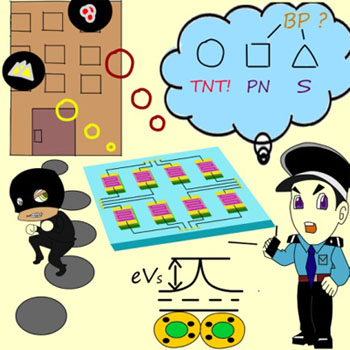Sensory Array Discriminatively Detects Improvised Explosives
Editor: | Jun 07,2016
The discriminative detection of improvised explosives is a difficult problem in the world due to the complex composition and low volatility. The sensing technology based on metal oxide or sulfide semiconductor, which has many advantages, such as simple preparation, non-contact detection, high stability, multi-function integration, low cost, etc., may shed light on the sensitive and discriminative detection of improvised explosives via a portable and integrated sensory array.
Metal sulfides have the similar physicochemical properties with metal oxides, and metal sulfide nanocrystals (NCs) have the advantages of simple preparation, large specific surface area, easy control of the surface state and so on. However, pure metal sulfide semiconductor, as sensing materials, has low sensitivity and thermal stability, and these shortcomings limit its wide application in the field of gas sensing.
To extend the possibility of metal sulfide NCs in the detection of explosive vapors, a research team led by Prof. DOU Xincun at Xinjiang Technical Institute of Physics & Chemistry of Chinese Academy of Sciences fabricated a sensory array to detect discriminatively two typical military explosives and six constituents relevant to improvised explosive devices (IEDs) within seven seconds via the sensory array based on ZnS NCs.
Researchers regulated the sensing properties of ZnS NCs by tailoring the doping concentration of Mn2+ and thus to manipulate the surface states. They found the content of Mn element in ZnS NCs increases significantly with the increase of the ratio of Mn/Zn in the precursor, and the sensor response value can reach the climate with an atomic ratio of 2.23%.
According to the built unique fingerprint pattern of each species by combining the kinetics and thermodynamics naturally inherent between the sensory array and the target analytes, the sensory array assembled with eight Mn:ZnS NCs-based sensors can uniquely recognize different constituents, such as DNT and TNT, within seven seconds at room temperature.
This study represents a facile, effective and reliable method to acquire a quality sensory array and opens up a new way to rapidly, sensitively and contactlessly recognize the constituents relevant to IEDs, making the on-the-spot detection of IEDs possible.
The result was published in Advanced Functional Materials entitled Contactless and Rapid Discrimination of Improvised Explosives Realized by Mn2+ Doping Tailored ZnS Nanocrystals.
The work was supported by the National Nature Science Foundation of China, the Hundred Talent Program of the Chinese Academy of Sciences, etc.

Schematic diagram of discriminative detection of the constituents relevant to IEDs (Image by DOU Xincun's group)
Contact:
Prof. DOU Xincun
E-mail: xcdou@ms.xjb.ac.cn
Xinjiang Technical Institute of Physics & Chemistry,CAS
附件下载:
 (86) 991-3838931
(86) 991-3838931 lhskj@ms.xjb.ac.cn
lhskj@ms.xjb.ac.cn (86)991-3838957
(86)991-3838957 40-1 Beijing Road
Urumqi, XinjiangChina
40-1 Beijing Road
Urumqi, XinjiangChina